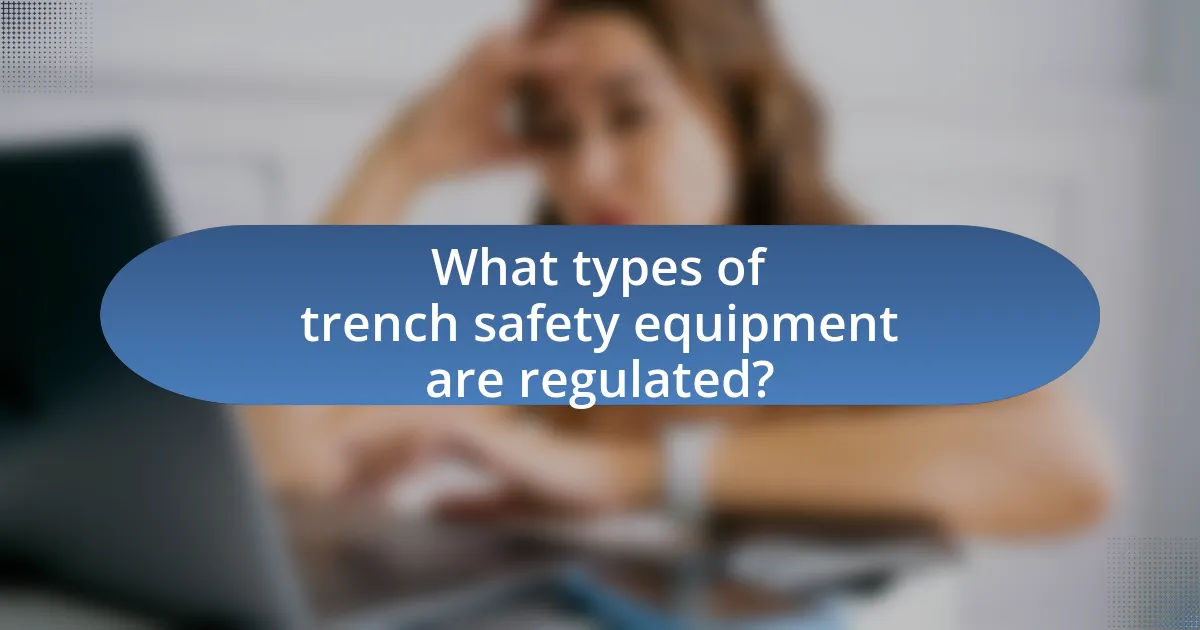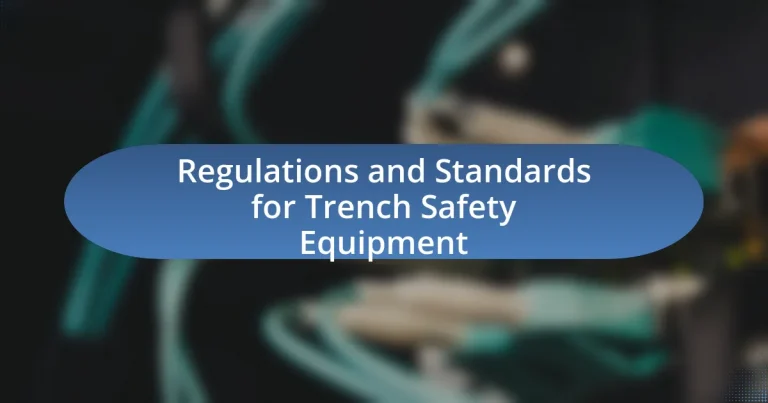The article focuses on the regulations and standards governing trench safety equipment, primarily highlighting the Occupational Safety and Health Administration (OSHA) standards outlined in 29 CFR Part 1926 Subpart P. It details the mandatory protective systems required for trenches, such as trench boxes and shoring, to prevent cave-ins, which are a leading cause of fatalities in excavation work. Additionally, the article examines the impact of federal and state regulations on trench safety, the role of industry standards, and the importance of training and compliance for organizations to ensure worker safety. It also addresses common challenges in adhering to these regulations and offers practical tips for enhancing the usage of trench safety equipment.

What are the key regulations governing trench safety equipment?
The key regulations governing trench safety equipment include the Occupational Safety and Health Administration (OSHA) standards, specifically 29 CFR Part 1926 Subpart P, which outlines requirements for excavation and trenching operations. These regulations mandate the use of protective systems, such as trench boxes or shoring, to prevent cave-ins, which are a leading cause of fatalities in excavation work. Additionally, the American National Standards Institute (ANSI) provides guidelines that complement OSHA standards, ensuring that trench safety equipment meets specific performance criteria. Compliance with these regulations is essential for safeguarding workers and minimizing risks associated with trenching activities.
How do federal regulations impact trench safety equipment standards?
Federal regulations significantly influence trench safety equipment standards by establishing mandatory safety requirements that protect workers from hazards associated with trenching operations. The Occupational Safety and Health Administration (OSHA) sets these regulations, which include specifications for protective systems, such as trench boxes and shoring, to prevent collapses. For instance, OSHA’s standard 29 CFR 1926.650 outlines the necessary precautions and equipment needed for trench safety, mandating that employers provide adequate protection based on trench depth and soil type. Compliance with these regulations is essential for minimizing risks and ensuring worker safety in excavation sites.
What specific OSHA standards apply to trench safety equipment?
The specific OSHA standards that apply to trench safety equipment are outlined in 29 CFR 1926 Subpart P, which addresses excavation and trenching safety. This regulation mandates that employers must provide protective systems for employees working in trenches deeper than five feet, including options such as trench boxes, shoring, and sloping. The standards are designed to prevent cave-ins, which are a leading cause of fatalities in excavation work, with OSHA reporting that approximately 23% of excavation-related fatalities are due to cave-ins.
How do state regulations vary regarding trench safety equipment?
State regulations regarding trench safety equipment vary significantly across the United States, with each state having its own specific requirements and standards. For instance, California mandates the use of protective systems for trenches deeper than five feet, while Texas follows federal OSHA guidelines, which require protective measures for trenches deeper than four feet. Additionally, states like New York have their own unique regulations that may include specific training requirements for workers involved in trenching operations. These variations reflect local safety concerns, geological conditions, and historical incidents, leading to a diverse regulatory landscape that necessitates compliance with both state and federal standards.
What role do industry standards play in trench safety equipment?
Industry standards are crucial in ensuring the safety and effectiveness of trench safety equipment. These standards provide guidelines for the design, testing, and use of equipment, thereby minimizing risks associated with trenching operations. For example, the Occupational Safety and Health Administration (OSHA) sets specific regulations that require protective systems for trenches deeper than five feet, which directly influences the manufacturing and implementation of safety equipment. Compliance with these standards not only enhances worker safety but also helps organizations avoid legal liabilities and financial penalties associated with non-compliance.
Which organizations establish standards for trench safety equipment?
The organizations that establish standards for trench safety equipment include the Occupational Safety and Health Administration (OSHA) and the American National Standards Institute (ANSI). OSHA sets federal regulations that govern trench safety practices to protect workers from hazards associated with trenching and excavation. ANSI develops consensus standards that provide guidelines for the design and use of trench safety equipment, ensuring it meets safety requirements. These organizations play a crucial role in promoting safe practices and equipment in the construction industry.
How do these standards ensure safety in trench operations?
Standards ensure safety in trench operations by mandating specific safety measures and equipment usage to prevent accidents and injuries. These regulations require the implementation of protective systems, such as trench boxes or shoring, to prevent collapses, which are a leading cause of fatalities in trench work. According to the Occupational Safety and Health Administration (OSHA), approximately 1 in 10 construction workers are injured in a trench-related incident, highlighting the critical need for adherence to these standards. Compliance with these regulations not only promotes safe work practices but also establishes guidelines for training workers on hazard recognition and emergency response, further enhancing safety in trench operations.

What types of trench safety equipment are regulated?
Regulated types of trench safety equipment include trench boxes, shoring systems, and protective systems designed to prevent cave-ins. These regulations are enforced by the Occupational Safety and Health Administration (OSHA), which mandates that any trench deeper than five feet must have adequate protective measures in place. Specifically, OSHA standards 1926.650 to 1926.652 outline the requirements for these safety systems, ensuring that workers are protected from potential hazards associated with trenching operations.
What are the primary categories of trench safety equipment?
The primary categories of trench safety equipment include protective systems, access and egress equipment, and personal protective equipment (PPE). Protective systems, such as trench boxes and shoring, are designed to prevent collapses and protect workers inside the trench. Access and egress equipment, like ladders and ramps, ensure safe entry and exit from trenches. Personal protective equipment includes hard hats, gloves, and safety boots, which safeguard workers from potential hazards. These categories are essential for compliance with OSHA regulations, which mandate specific safety measures to prevent trench-related accidents and injuries.
What is the purpose of trench boxes and shields?
The purpose of trench boxes and shields is to provide protective support for workers in excavations, preventing soil collapse and ensuring safety during trenching operations. Trench boxes, also known as trench shields, are designed to be placed in the trench to create a safe working environment by supporting the walls of the excavation. According to OSHA regulations, these devices are essential for protecting workers from cave-ins, which are a leading cause of fatalities in excavation work, with statistics indicating that approximately 25% of excavation-related deaths are due to collapses.
How do personal protective equipment (PPE) regulations apply to trench work?
Personal protective equipment (PPE) regulations mandate that workers engaged in trench work must wear specific safety gear to minimize risks associated with cave-ins, falls, and hazardous materials. The Occupational Safety and Health Administration (OSHA) outlines these requirements, emphasizing the use of hard hats, steel-toed boots, high-visibility clothing, and respiratory protection when necessary. For instance, OSHA’s standard 1926.652 requires protective systems for trenches deeper than five feet, which often necessitates the use of PPE to ensure worker safety in conjunction with these systems.
What are the requirements for inspection and maintenance of trench safety equipment?
The requirements for inspection and maintenance of trench safety equipment include regular visual inspections, functionality checks, and adherence to manufacturer guidelines. Specifically, OSHA mandates that trench safety equipment, such as protective systems, must be inspected by a competent person before each shift and after any event that could affect the equipment’s integrity. Additionally, maintenance must be performed as needed to ensure that the equipment remains in safe working condition, which includes repairing or replacing any damaged components. These regulations are outlined in OSHA Standard 1926.650, which emphasizes the importance of maintaining the safety and effectiveness of trench safety equipment to prevent accidents and injuries.
How often should trench safety equipment be inspected?
Trench safety equipment should be inspected daily before use. This frequency is mandated by OSHA regulations, specifically under 29 CFR 1926.651, which requires that inspections occur at the start of each shift and as conditions change. Regular inspections help ensure the safety and integrity of the equipment, reducing the risk of accidents and injuries in trenching operations.
What documentation is required for trench safety equipment maintenance?
Documentation required for trench safety equipment maintenance includes inspection records, maintenance logs, and training certifications. Inspection records must detail the condition and functionality of the equipment, while maintenance logs should track repairs and servicing performed. Training certifications are necessary to ensure that personnel are qualified to operate and maintain the equipment, complying with OSHA regulations, which mandate that employers maintain records of safety training and equipment inspections to ensure workplace safety.

How can organizations ensure compliance with trench safety regulations?
Organizations can ensure compliance with trench safety regulations by implementing comprehensive training programs for employees, conducting regular inspections, and adhering to established safety standards such as those set by the Occupational Safety and Health Administration (OSHA). Training programs educate workers on the hazards associated with trenching and the proper use of safety equipment, while regular inspections help identify and mitigate risks before they lead to accidents. Compliance with OSHA standards, which include requirements for protective systems and safe work practices, provides a framework for organizations to follow, ensuring that they meet legal obligations and promote a safe working environment.
What training is necessary for workers using trench safety equipment?
Workers using trench safety equipment must undergo training that includes understanding trench hazards, proper use of protective systems, and emergency response procedures. This training is essential to ensure compliance with OSHA regulations, specifically 29 CFR 1926.650-652, which mandate that workers are trained to recognize and avoid unsafe conditions in and around trenches. Additionally, training should cover the identification of soil types, the selection of appropriate protective measures, and the use of personal protective equipment (PPE). This comprehensive training helps prevent accidents and injuries associated with trench work, reinforcing the importance of safety in excavation operations.
What topics should be covered in trench safety training programs?
Trench safety training programs should cover topics such as hazard recognition, protective systems, soil classification, excavation safety, and emergency procedures. These topics are essential to ensure that workers understand the risks associated with trenching and the necessary precautions to take. For instance, the Occupational Safety and Health Administration (OSHA) mandates that workers be trained on the specific hazards of trenching, including the types of protective systems required based on soil conditions. Additionally, training should include the proper use of equipment and tools, as well as the importance of regular inspections and monitoring of trench conditions to prevent accidents.
How can organizations assess the effectiveness of their training programs?
Organizations can assess the effectiveness of their training programs by utilizing a combination of evaluation methods such as pre- and post-training assessments, participant feedback, and performance metrics. Pre- and post-training assessments measure knowledge and skill acquisition, while participant feedback provides insights into the training experience and perceived relevance. Performance metrics, such as changes in safety incident rates or compliance with regulations, offer concrete evidence of the training’s impact on workplace behavior and safety outcomes. For instance, a study by the National Safety Council found that organizations implementing structured training programs saw a 20% reduction in workplace accidents, demonstrating the correlation between effective training and improved safety performance.
What best practices should organizations follow for trench safety compliance?
Organizations should follow best practices such as conducting thorough site assessments, implementing protective systems, and ensuring proper training for workers to achieve trench safety compliance. Conducting site assessments involves evaluating soil conditions, water levels, and potential hazards, which is essential for determining the appropriate protective measures. Implementing protective systems, such as trench boxes or shoring, is critical to prevent collapses, as trench collapses account for a significant percentage of excavation-related fatalities, according to the Occupational Safety and Health Administration (OSHA). Additionally, providing comprehensive training ensures that workers understand safety protocols and recognize hazards, which is vital since OSHA mandates that all employees working in or around trenches receive adequate training.
How can regular audits improve trench safety compliance?
Regular audits can significantly improve trench safety compliance by systematically identifying and addressing safety deficiencies. These audits evaluate adherence to safety regulations, such as those outlined by the Occupational Safety and Health Administration (OSHA), which mandates specific safety measures for trenching operations. By conducting regular audits, organizations can ensure that safety protocols are being followed, equipment is properly maintained, and workers are trained in safe practices. For instance, a study by the National Institute for Occupational Safety and Health (NIOSH) found that regular safety inspections reduced trench-related accidents by 30%. This evidence underscores the effectiveness of audits in enhancing compliance and ultimately safeguarding workers in trenching environments.
What role does employee feedback play in enhancing trench safety practices?
Employee feedback is crucial in enhancing trench safety practices as it provides firsthand insights into potential hazards and the effectiveness of existing safety measures. When employees share their experiences and observations, organizations can identify gaps in safety protocols and implement necessary changes. For instance, a study by the National Institute for Occupational Safety and Health (NIOSH) found that incorporating worker feedback led to a 30% reduction in trench-related accidents, demonstrating the tangible benefits of actively engaging employees in safety discussions. This feedback loop not only fosters a culture of safety but also ensures that safety practices are continuously improved based on real-world conditions and employee input.
What are common challenges in adhering to trench safety regulations?
Common challenges in adhering to trench safety regulations include inadequate training, lack of proper equipment, and insufficient supervision. Inadequate training often leads to workers not fully understanding safety protocols, which increases the risk of accidents. The lack of proper equipment, such as shoring and protective systems, can result in non-compliance with safety standards, as workers may not have the necessary tools to create a safe working environment. Insufficient supervision can further exacerbate these issues, as it may lead to a failure in enforcing safety practices and monitoring compliance with regulations. According to the Occupational Safety and Health Administration (OSHA), trench collapses are a leading cause of fatalities in excavation work, highlighting the critical need for adherence to safety regulations.
How can organizations overcome barriers to compliance?
Organizations can overcome barriers to compliance by implementing comprehensive training programs that educate employees on regulations and standards specific to trench safety equipment. Such training ensures that all personnel understand the legal requirements and best practices, which is crucial for maintaining safety and compliance. According to the Occupational Safety and Health Administration (OSHA), effective training can significantly reduce workplace accidents and improve adherence to safety regulations. Additionally, organizations should conduct regular audits and assessments to identify compliance gaps and address them proactively, thereby fostering a culture of safety and accountability.
What resources are available for organizations struggling with trench safety regulations?
Organizations struggling with trench safety regulations can access several resources, including the Occupational Safety and Health Administration (OSHA) guidelines, which provide comprehensive standards for trench safety. OSHA offers training programs, compliance assistance, and publications that detail safety requirements and best practices for trenching operations. Additionally, the National Utility Contractors Association (NUCA) provides resources such as safety training, webinars, and industry-specific guidelines to help organizations comply with trench safety regulations. Furthermore, local safety councils and industry associations often offer workshops and seminars focused on trench safety, enhancing knowledge and compliance among organizations.
What practical tips can enhance trench safety equipment usage?
To enhance trench safety equipment usage, ensure regular inspections and maintenance of all equipment. Regular checks help identify wear and tear, ensuring that safety gear functions correctly and complies with OSHA regulations, which mandate that trench safety equipment must be maintained in safe working condition. Additionally, provide comprehensive training for all personnel on the proper use of trench safety equipment, as studies show that well-trained workers are 50% less likely to experience accidents. Implementing a clear communication system on-site can also improve safety, as it allows for immediate reporting of hazards or equipment failures, thereby reducing risks associated with trench work.


